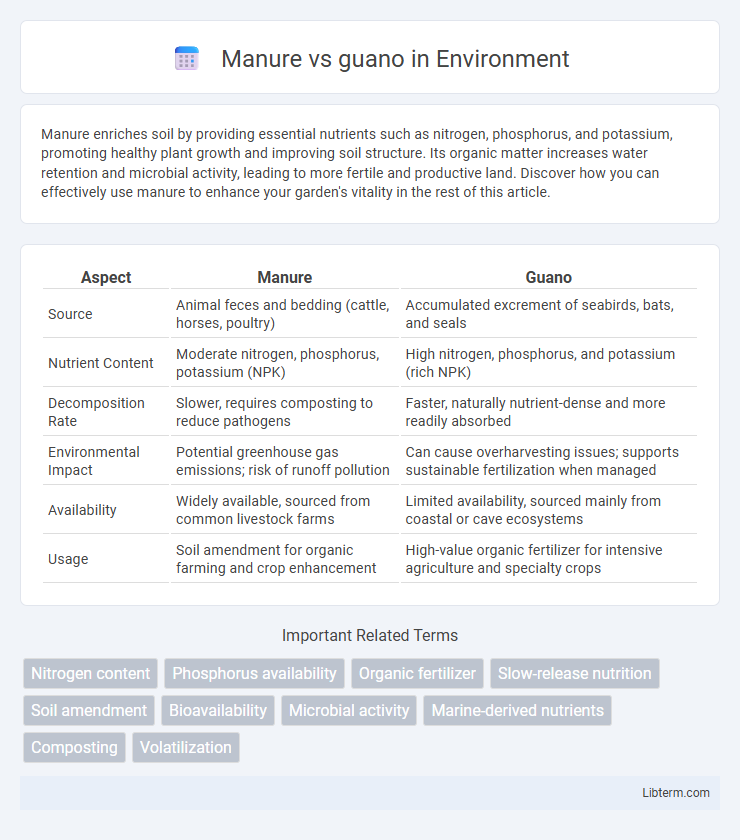Manure enriches soil by providing essential nutrients such as nitrogen, phosphorus, and potassium, promoting healthy plant growth and improving soil structure. Its organic matter increases water retention and microbial activity, leading to more fertile and productive land. Discover how you can effectively use manure to enhance your garden's vitality in the rest of this article.
Table of Comparison
| Aspect | Manure | Guano |
|---|---|---|
| Source | Animal feces and bedding (cattle, horses, poultry) | Accumulated excrement of seabirds, bats, and seals |
| Nutrient Content | Moderate nitrogen, phosphorus, potassium (NPK) | High nitrogen, phosphorus, and potassium (rich NPK) |
| Decomposition Rate | Slower, requires composting to reduce pathogens | Faster, naturally nutrient-dense and more readily absorbed |
| Environmental Impact | Potential greenhouse gas emissions; risk of runoff pollution | Can cause overharvesting issues; supports sustainable fertilization when managed |
| Availability | Widely available, sourced from common livestock farms | Limited availability, sourced mainly from coastal or cave ecosystems |
| Usage | Soil amendment for organic farming and crop enhancement | High-value organic fertilizer for intensive agriculture and specialty crops |
Introduction: Manure and Guano Defined
Manure refers to organic matter, primarily animal feces mixed with bedding material, used as fertilizer to enrich soil nutrients such as nitrogen, phosphorus, and potassium. Guano is the accumulated excrement of seabirds or bats, highly valued for its concentrated levels of nitrogen, phosphate, and potassium, making it a potent natural fertilizer. Both substances play crucial roles in sustainable agriculture by enhancing soil fertility and promoting plant growth.
Historical Uses of Manure and Guano
Manure has been used historically as a fertilizer for thousands of years, with ancient civilizations like the Egyptians and Mesopotamians applying animal waste to enrich soil and enhance crop yields. Guano, composed of accumulated seabird or bat excrement, gained prominence in the 19th century as a highly concentrated source of nitrogen, phosphate, and potassium, revolutionizing agriculture and boosting productivity worldwide. The historical use of both manure and guano significantly contributed to the development of sustainable farming practices and global food security.
Nutrient Composition: Manure vs Guano
Manure typically contains a balanced mix of nitrogen (N), phosphorus (P), and potassium (K), with nitrogen levels ranging from 0.5-2% and phosphorus around 0.2-1%, making it effective for general soil fertility. Guano offers a higher concentration of nutrients, especially phosphorus (up to 12%) and nitrogen (up to 10%), along with trace minerals like calcium and magnesium that promote robust plant growth. The nutrient composition of guano makes it a potent fertilizer for phosphorus-deficient soils, while manure provides a slower nutrient release suitable for sustained soil enrichment.
Sources and Collection Methods
Manure primarily originates from domesticated animals such as cattle, horses, and poultry, collected directly from farms through regular cleaning of animal enclosures. Guano is accumulated from the excrement of seabirds, bats, and seals, harvested from caves, coastal islands, or cliffs where these animals congregate in large colonies. Collection methods for manure involve manual or mechanical gathering and composting, while guano harvesting requires careful physical extraction to preserve natural habitats and ensure sustainable replenishment.
Application in Modern Agriculture
Manure and guano serve distinct roles in modern agriculture, each offering unique nutrient profiles that enhance soil fertility. Manure, derived from livestock waste, provides a balanced supply of nitrogen, phosphorus, and potassium, improving soil structure and microbial activity. Guano, rich in nitrogen and phosphorus, acts as a potent organic fertilizer, accelerating crop growth and boosting yields, particularly in nutrient-deficient soils.
Environmental Impact Comparison
Manure and guano differ significantly in environmental impact; manure, derived from livestock waste, often contains high nitrogen and phosphorus levels that can lead to water pollution through runoff and leaching. Guano, formed from accumulated seabird or bat droppings, is rich in nutrients like nitrogen, phosphorus, and potassium but is typically harvested more sustainably with less risk of chemical runoff when managed properly. Guano's natural origin and slower nutrient release contribute to improved soil health and reduced greenhouse gas emissions compared to synthetic fertilizers and excessive manure application.
Cost and Availability Factors
Manure is generally more cost-effective and widely available due to its common production on farms and livestock operations, making it accessible for large-scale agricultural use. Guano, sourced from bat or seabird droppings, tends to be more expensive and less readily available because it requires specific harvesting locations and conservation regulations. The cost differential and supply limitations often make manure the preferred choice for farmers seeking affordable and abundant organic fertilizer.
Benefits of Manure in Soil Health
Manure enriches soil with essential nutrients such as nitrogen, phosphorus, and potassium, promoting robust plant growth and improved crop yields. Its organic matter enhances soil structure, water retention, and microbial activity, resulting in healthier and more fertile soil. Unlike guano, which is nutrient-rich but less abundant, manure provides a sustainable and cost-effective source for long-term soil health maintenance.
Advantages of Guano for Plant Growth
Guano, rich in essential nutrients such as nitrogen, phosphorus, and potassium, significantly enhances plant growth by improving soil fertility and structure. Its high concentration of organic matter promotes microbial activity, leading to better nutrient availability and soil aeration. Compared to traditional manure, guano offers faster nutrient release and higher efficiency in supporting vigorous plant development and increased crop yields.
Choosing the Right Fertilizer for Your Needs
Manure, rich in nitrogen and organic matter, improves soil structure and moisture retention, making it ideal for vegetable gardens and flower beds. Guano, derived from seabird or bat droppings, offers a potent source of nitrogen, phosphorus, and potassium, perfect for boosting plant growth and flowering quickly. Selecting the right fertilizer depends on soil nutrient requirements, crop type, and desired growth speed, with manure favoring long-term soil health and guano providing fast-acting nutrient availability.
Manure Infographic

 libterm.com
libterm.com